Analysis of Wearable Sensing Technologies and Healthcare Impact
VerifiedAdded on 2023/04/21
|15
|3277
|473
Report
AI Summary
This report provides a critical evaluation of wearable sensing technologies, particularly focusing on their applications in healthcare and the security issues associated with their use. It begins by identifying the research problem related to data security risks with increasing use of wireless sensing technology. The literature review covers the concept of wearable sensing technology, different types of activity monitoring, and a detailed analysis of the identified security concerns. It discusses the advantages of wearable sensors in healthcare, such as continuous physiological monitoring and improved patient care, while also addressing the privacy and security challenges that need to be considered. The report highlights the potential of wearable sensing devices in early disease detection, chronic disease prevention, and emergency response, emphasizing the need for ongoing research to ensure the secure and effective implementation of these technologies. Desklib offers a variety of resources, including past papers and solved assignments, to further explore this topic.
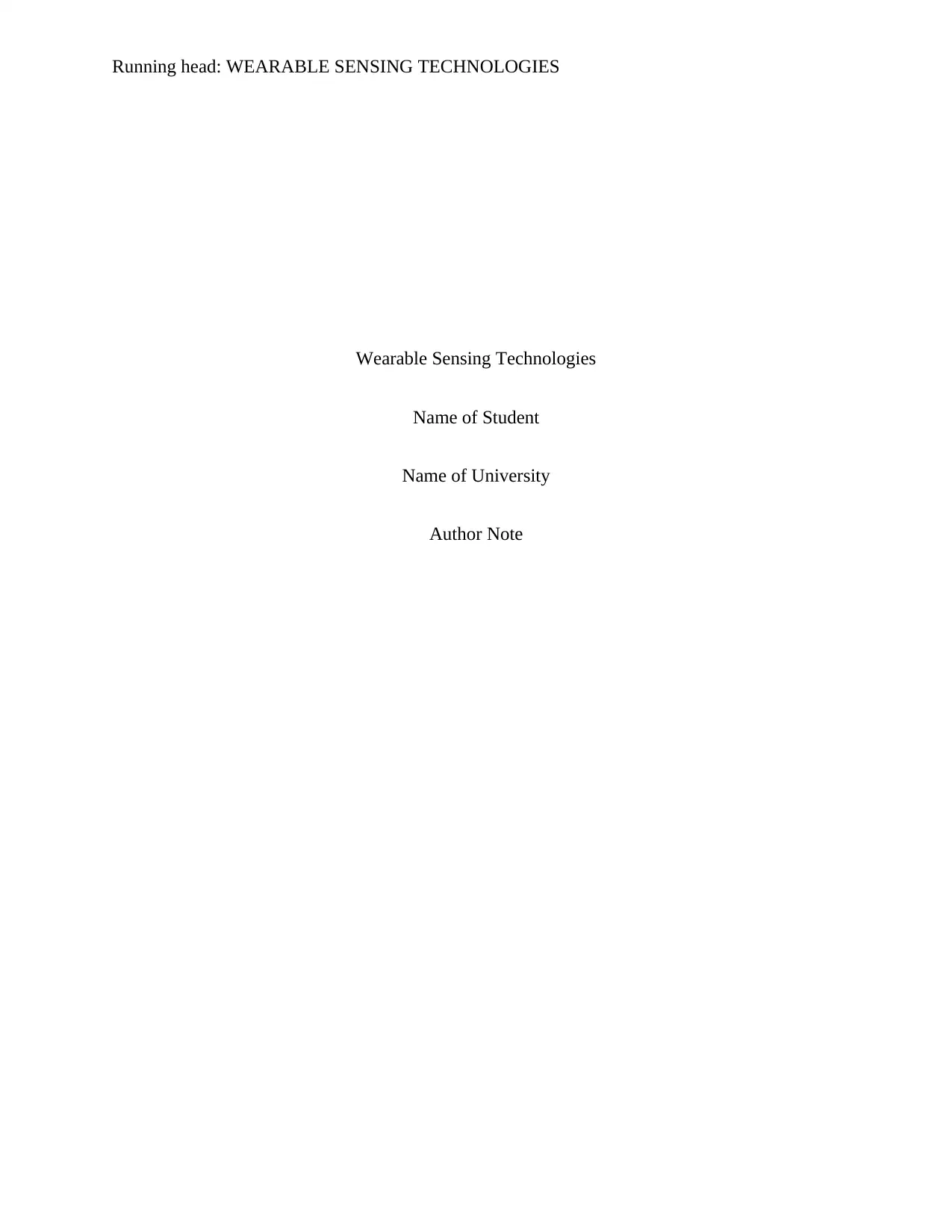
Running head: WEARABLE SENSING TECHNOLOGIES
Wearable Sensing Technologies
Name of Student
Name of University
Author Note
Wearable Sensing Technologies
Name of Student
Name of University
Author Note
Paraphrase This Document
Need a fresh take? Get an instant paraphrase of this document with our AI Paraphraser
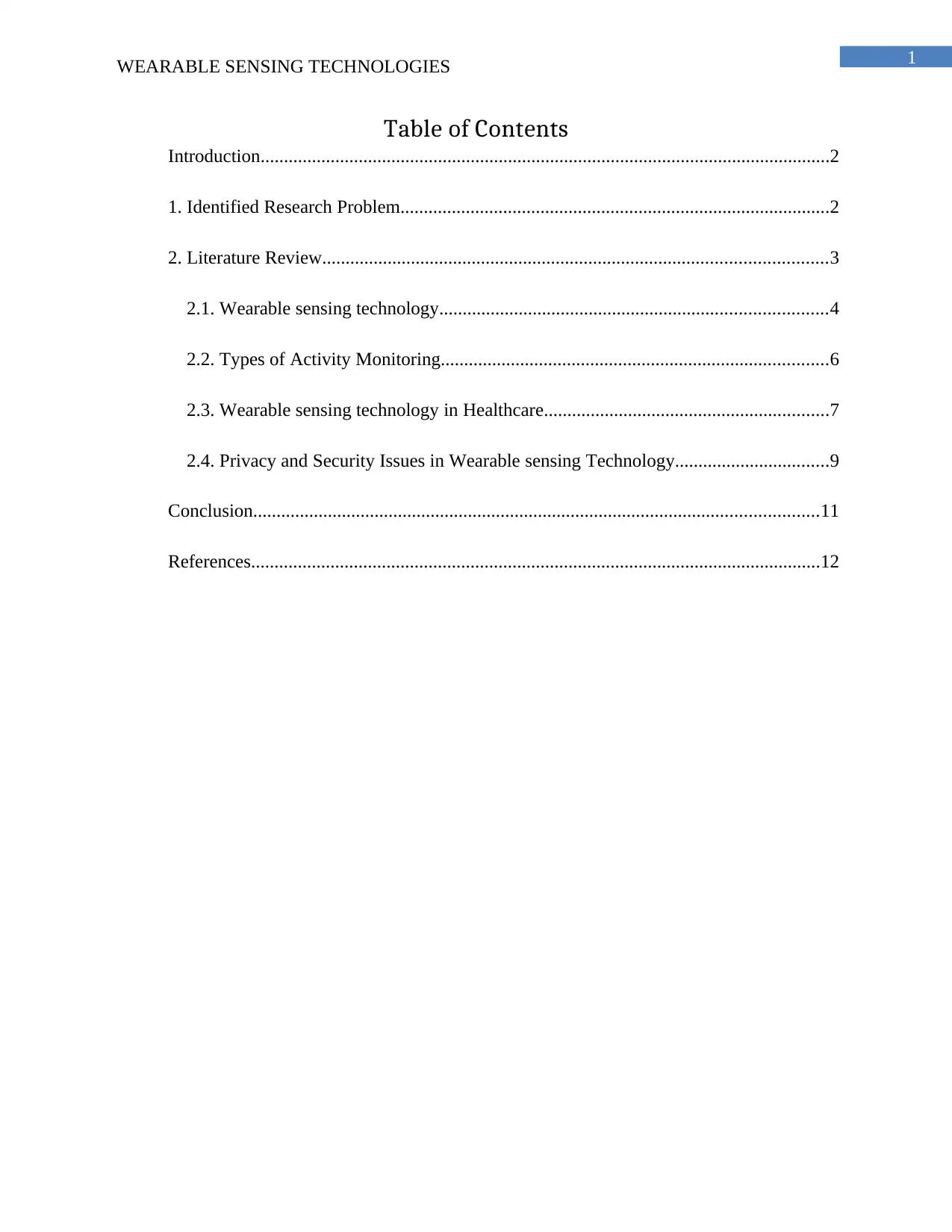
1WEARABLE SENSING TECHNOLOGIES
Table of Contents
Introduction..........................................................................................................................2
1. Identified Research Problem............................................................................................2
2. Literature Review............................................................................................................3
2.1. Wearable sensing technology...................................................................................4
2.2. Types of Activity Monitoring...................................................................................6
2.3. Wearable sensing technology in Healthcare.............................................................7
2.4. Privacy and Security Issues in Wearable sensing Technology.................................9
Conclusion.........................................................................................................................11
References..........................................................................................................................12
Table of Contents
Introduction..........................................................................................................................2
1. Identified Research Problem............................................................................................2
2. Literature Review............................................................................................................3
2.1. Wearable sensing technology...................................................................................4
2.2. Types of Activity Monitoring...................................................................................6
2.3. Wearable sensing technology in Healthcare.............................................................7
2.4. Privacy and Security Issues in Wearable sensing Technology.................................9
Conclusion.........................................................................................................................11
References..........................................................................................................................12
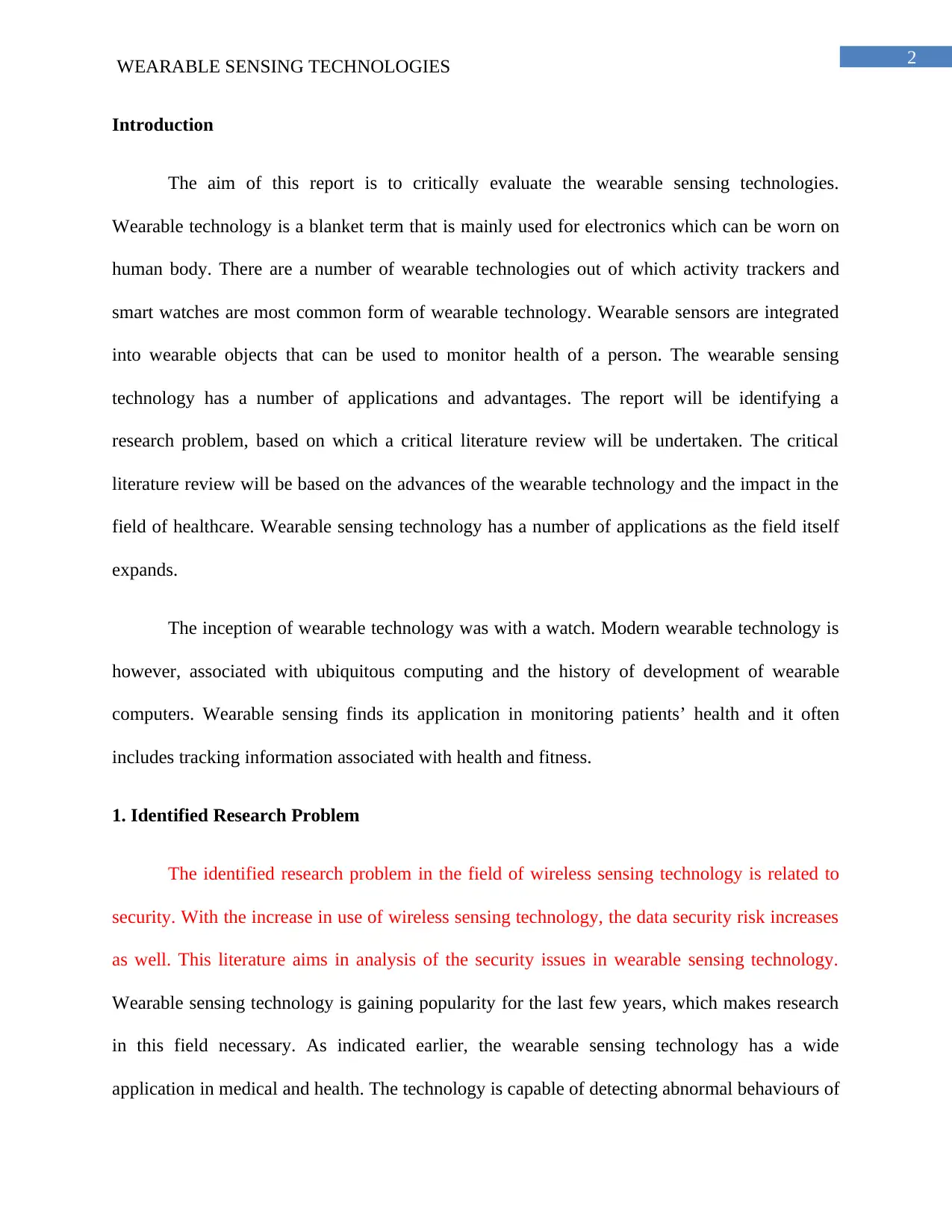
2WEARABLE SENSING TECHNOLOGIES
Introduction
The aim of this report is to critically evaluate the wearable sensing technologies.
Wearable technology is a blanket term that is mainly used for electronics which can be worn on
human body. There are a number of wearable technologies out of which activity trackers and
smart watches are most common form of wearable technology. Wearable sensors are integrated
into wearable objects that can be used to monitor health of a person. The wearable sensing
technology has a number of applications and advantages. The report will be identifying a
research problem, based on which a critical literature review will be undertaken. The critical
literature review will be based on the advances of the wearable technology and the impact in the
field of healthcare. Wearable sensing technology has a number of applications as the field itself
expands.
The inception of wearable technology was with a watch. Modern wearable technology is
however, associated with ubiquitous computing and the history of development of wearable
computers. Wearable sensing finds its application in monitoring patients’ health and it often
includes tracking information associated with health and fitness.
1. Identified Research Problem
The identified research problem in the field of wireless sensing technology is related to
security. With the increase in use of wireless sensing technology, the data security risk increases
as well. This literature aims in analysis of the security issues in wearable sensing technology.
Wearable sensing technology is gaining popularity for the last few years, which makes research
in this field necessary. As indicated earlier, the wearable sensing technology has a wide
application in medical and health. The technology is capable of detecting abnormal behaviours of
Introduction
The aim of this report is to critically evaluate the wearable sensing technologies.
Wearable technology is a blanket term that is mainly used for electronics which can be worn on
human body. There are a number of wearable technologies out of which activity trackers and
smart watches are most common form of wearable technology. Wearable sensors are integrated
into wearable objects that can be used to monitor health of a person. The wearable sensing
technology has a number of applications and advantages. The report will be identifying a
research problem, based on which a critical literature review will be undertaken. The critical
literature review will be based on the advances of the wearable technology and the impact in the
field of healthcare. Wearable sensing technology has a number of applications as the field itself
expands.
The inception of wearable technology was with a watch. Modern wearable technology is
however, associated with ubiquitous computing and the history of development of wearable
computers. Wearable sensing finds its application in monitoring patients’ health and it often
includes tracking information associated with health and fitness.
1. Identified Research Problem
The identified research problem in the field of wireless sensing technology is related to
security. With the increase in use of wireless sensing technology, the data security risk increases
as well. This literature aims in analysis of the security issues in wearable sensing technology.
Wearable sensing technology is gaining popularity for the last few years, which makes research
in this field necessary. As indicated earlier, the wearable sensing technology has a wide
application in medical and health. The technology is capable of detecting abnormal behaviours of
⊘ This is a preview!⊘
Do you want full access?
Subscribe today to unlock all pages.

Trusted by 1+ million students worldwide
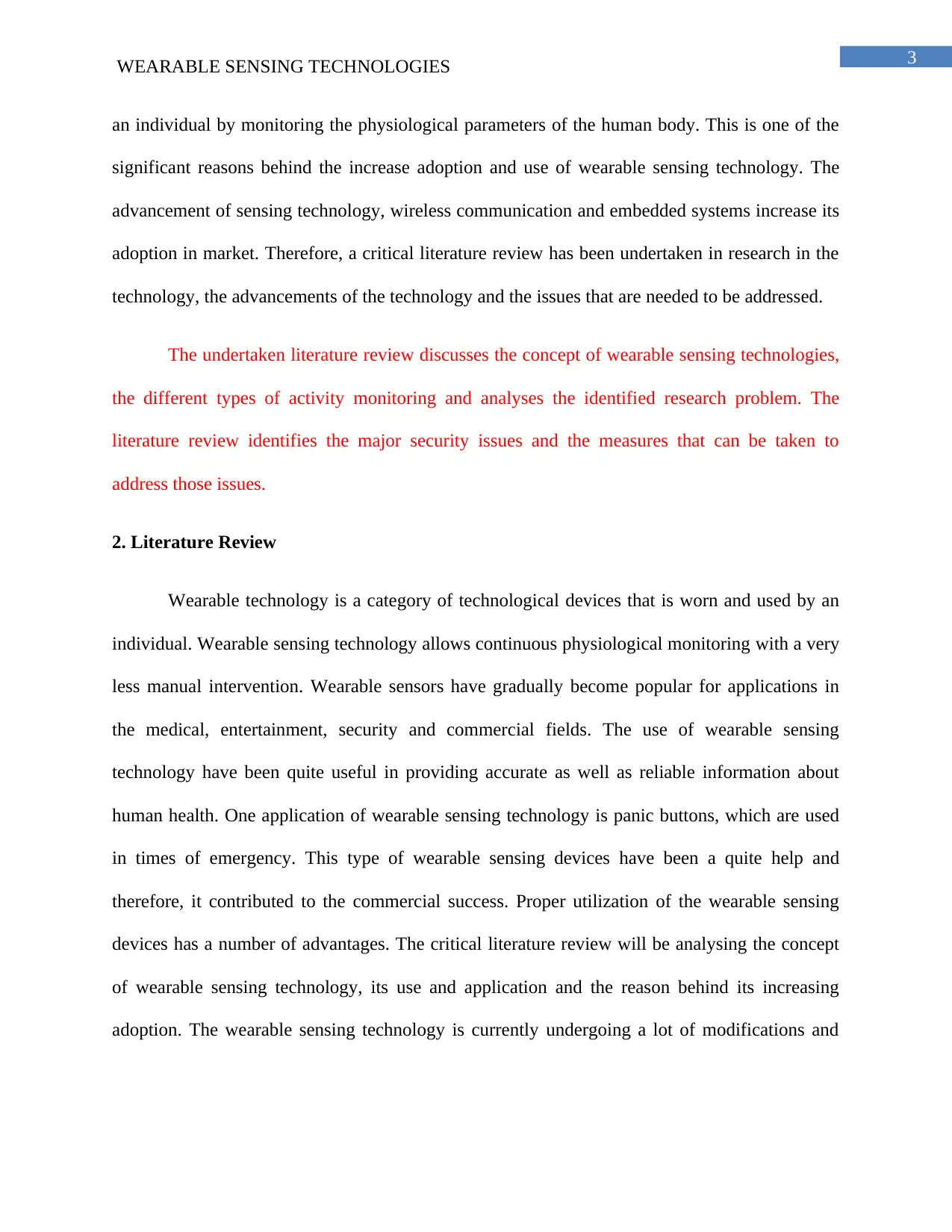
3WEARABLE SENSING TECHNOLOGIES
an individual by monitoring the physiological parameters of the human body. This is one of the
significant reasons behind the increase adoption and use of wearable sensing technology. The
advancement of sensing technology, wireless communication and embedded systems increase its
adoption in market. Therefore, a critical literature review has been undertaken in research in the
technology, the advancements of the technology and the issues that are needed to be addressed.
The undertaken literature review discusses the concept of wearable sensing technologies,
the different types of activity monitoring and analyses the identified research problem. The
literature review identifies the major security issues and the measures that can be taken to
address those issues.
2. Literature Review
Wearable technology is a category of technological devices that is worn and used by an
individual. Wearable sensing technology allows continuous physiological monitoring with a very
less manual intervention. Wearable sensors have gradually become popular for applications in
the medical, entertainment, security and commercial fields. The use of wearable sensing
technology have been quite useful in providing accurate as well as reliable information about
human health. One application of wearable sensing technology is panic buttons, which are used
in times of emergency. This type of wearable sensing devices have been a quite help and
therefore, it contributed to the commercial success. Proper utilization of the wearable sensing
devices has a number of advantages. The critical literature review will be analysing the concept
of wearable sensing technology, its use and application and the reason behind its increasing
adoption. The wearable sensing technology is currently undergoing a lot of modifications and
an individual by monitoring the physiological parameters of the human body. This is one of the
significant reasons behind the increase adoption and use of wearable sensing technology. The
advancement of sensing technology, wireless communication and embedded systems increase its
adoption in market. Therefore, a critical literature review has been undertaken in research in the
technology, the advancements of the technology and the issues that are needed to be addressed.
The undertaken literature review discusses the concept of wearable sensing technologies,
the different types of activity monitoring and analyses the identified research problem. The
literature review identifies the major security issues and the measures that can be taken to
address those issues.
2. Literature Review
Wearable technology is a category of technological devices that is worn and used by an
individual. Wearable sensing technology allows continuous physiological monitoring with a very
less manual intervention. Wearable sensors have gradually become popular for applications in
the medical, entertainment, security and commercial fields. The use of wearable sensing
technology have been quite useful in providing accurate as well as reliable information about
human health. One application of wearable sensing technology is panic buttons, which are used
in times of emergency. This type of wearable sensing devices have been a quite help and
therefore, it contributed to the commercial success. Proper utilization of the wearable sensing
devices has a number of advantages. The critical literature review will be analysing the concept
of wearable sensing technology, its use and application and the reason behind its increasing
adoption. The wearable sensing technology is currently undergoing a lot of modifications and
Paraphrase This Document
Need a fresh take? Get an instant paraphrase of this document with our AI Paraphraser
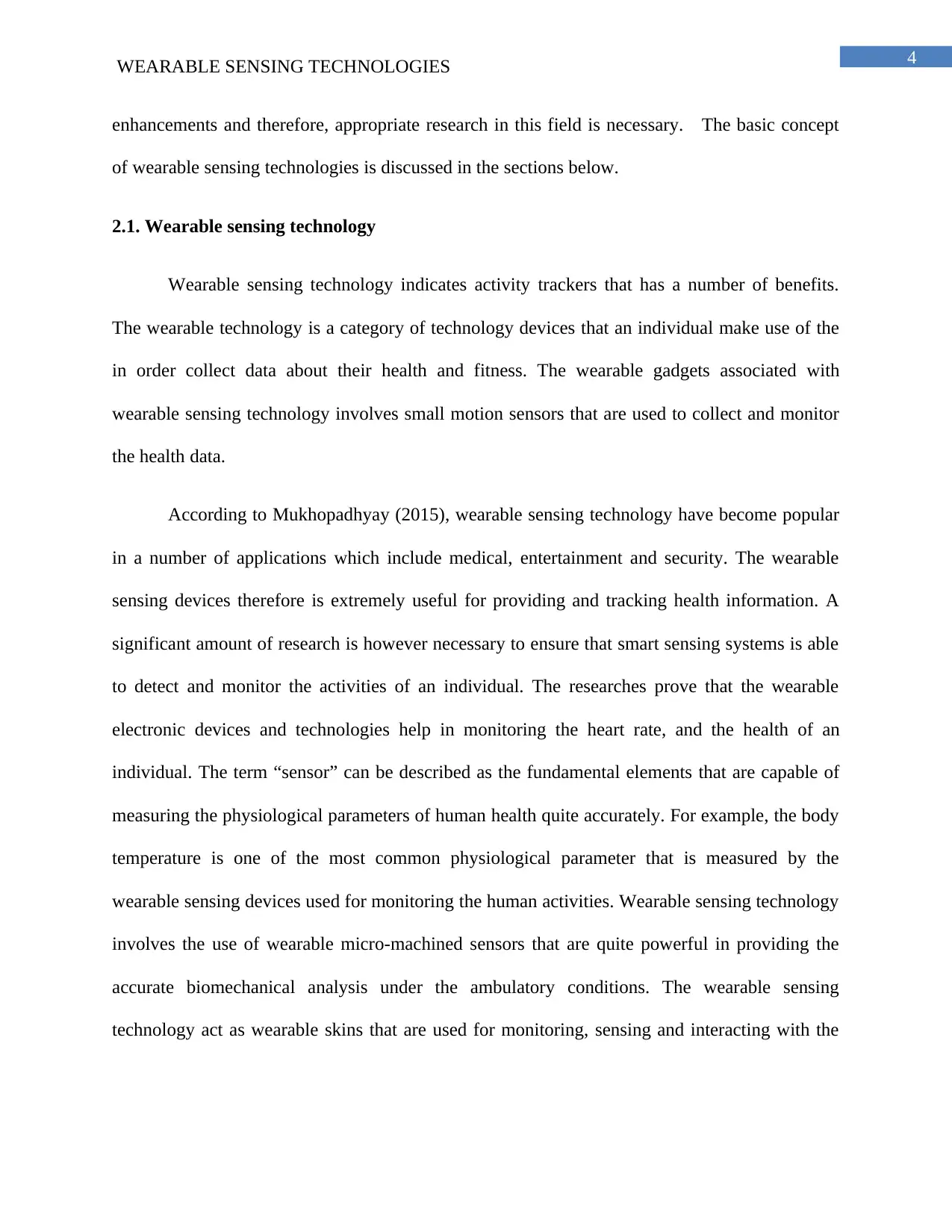
4WEARABLE SENSING TECHNOLOGIES
enhancements and therefore, appropriate research in this field is necessary. The basic concept
of wearable sensing technologies is discussed in the sections below.
2.1. Wearable sensing technology
Wearable sensing technology indicates activity trackers that has a number of benefits.
The wearable technology is a category of technology devices that an individual make use of the
in order collect data about their health and fitness. The wearable gadgets associated with
wearable sensing technology involves small motion sensors that are used to collect and monitor
the health data.
According to Mukhopadhyay (2015), wearable sensing technology have become popular
in a number of applications which include medical, entertainment and security. The wearable
sensing devices therefore is extremely useful for providing and tracking health information. A
significant amount of research is however necessary to ensure that smart sensing systems is able
to detect and monitor the activities of an individual. The researches prove that the wearable
electronic devices and technologies help in monitoring the heart rate, and the health of an
individual. The term “sensor” can be described as the fundamental elements that are capable of
measuring the physiological parameters of human health quite accurately. For example, the body
temperature is one of the most common physiological parameter that is measured by the
wearable sensing devices used for monitoring the human activities. Wearable sensing technology
involves the use of wearable micro-machined sensors that are quite powerful in providing the
accurate biomechanical analysis under the ambulatory conditions. The wearable sensing
technology act as wearable skins that are used for monitoring, sensing and interacting with the
enhancements and therefore, appropriate research in this field is necessary. The basic concept
of wearable sensing technologies is discussed in the sections below.
2.1. Wearable sensing technology
Wearable sensing technology indicates activity trackers that has a number of benefits.
The wearable technology is a category of technology devices that an individual make use of the
in order collect data about their health and fitness. The wearable gadgets associated with
wearable sensing technology involves small motion sensors that are used to collect and monitor
the health data.
According to Mukhopadhyay (2015), wearable sensing technology have become popular
in a number of applications which include medical, entertainment and security. The wearable
sensing devices therefore is extremely useful for providing and tracking health information. A
significant amount of research is however necessary to ensure that smart sensing systems is able
to detect and monitor the activities of an individual. The researches prove that the wearable
electronic devices and technologies help in monitoring the heart rate, and the health of an
individual. The term “sensor” can be described as the fundamental elements that are capable of
measuring the physiological parameters of human health quite accurately. For example, the body
temperature is one of the most common physiological parameter that is measured by the
wearable sensing devices used for monitoring the human activities. Wearable sensing technology
involves the use of wearable micro-machined sensors that are quite powerful in providing the
accurate biomechanical analysis under the ambulatory conditions. The wearable sensing
technology act as wearable skins that are used for monitoring, sensing and interacting with the
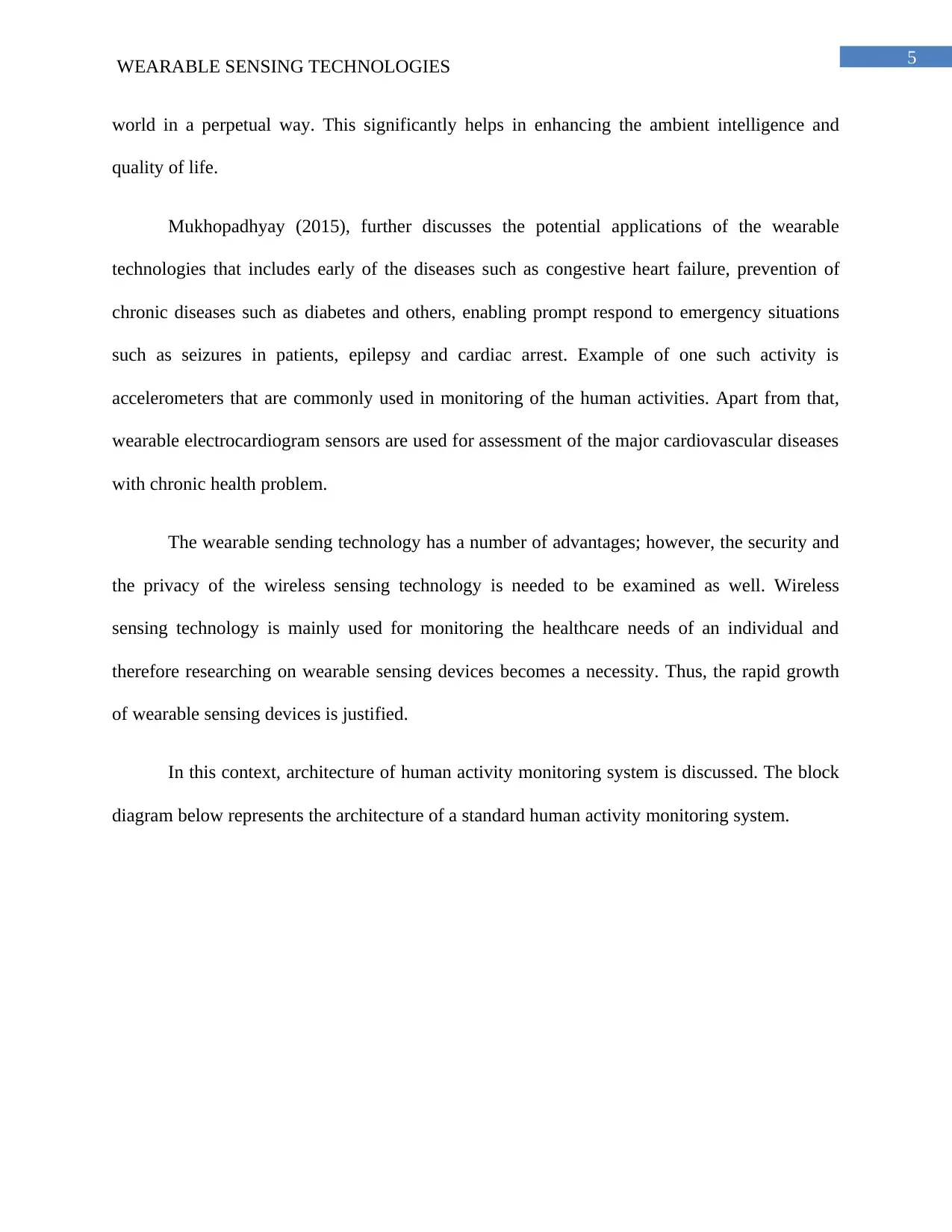
5WEARABLE SENSING TECHNOLOGIES
world in a perpetual way. This significantly helps in enhancing the ambient intelligence and
quality of life.
Mukhopadhyay (2015), further discusses the potential applications of the wearable
technologies that includes early of the diseases such as congestive heart failure, prevention of
chronic diseases such as diabetes and others, enabling prompt respond to emergency situations
such as seizures in patients, epilepsy and cardiac arrest. Example of one such activity is
accelerometers that are commonly used in monitoring of the human activities. Apart from that,
wearable electrocardiogram sensors are used for assessment of the major cardiovascular diseases
with chronic health problem.
The wearable sending technology has a number of advantages; however, the security and
the privacy of the wireless sensing technology is needed to be examined as well. Wireless
sensing technology is mainly used for monitoring the healthcare needs of an individual and
therefore researching on wearable sensing devices becomes a necessity. Thus, the rapid growth
of wearable sensing devices is justified.
In this context, architecture of human activity monitoring system is discussed. The block
diagram below represents the architecture of a standard human activity monitoring system.
world in a perpetual way. This significantly helps in enhancing the ambient intelligence and
quality of life.
Mukhopadhyay (2015), further discusses the potential applications of the wearable
technologies that includes early of the diseases such as congestive heart failure, prevention of
chronic diseases such as diabetes and others, enabling prompt respond to emergency situations
such as seizures in patients, epilepsy and cardiac arrest. Example of one such activity is
accelerometers that are commonly used in monitoring of the human activities. Apart from that,
wearable electrocardiogram sensors are used for assessment of the major cardiovascular diseases
with chronic health problem.
The wearable sending technology has a number of advantages; however, the security and
the privacy of the wireless sensing technology is needed to be examined as well. Wireless
sensing technology is mainly used for monitoring the healthcare needs of an individual and
therefore researching on wearable sensing devices becomes a necessity. Thus, the rapid growth
of wearable sensing devices is justified.
In this context, architecture of human activity monitoring system is discussed. The block
diagram below represents the architecture of a standard human activity monitoring system.
⊘ This is a preview!⊘
Do you want full access?
Subscribe today to unlock all pages.

Trusted by 1+ million students worldwide
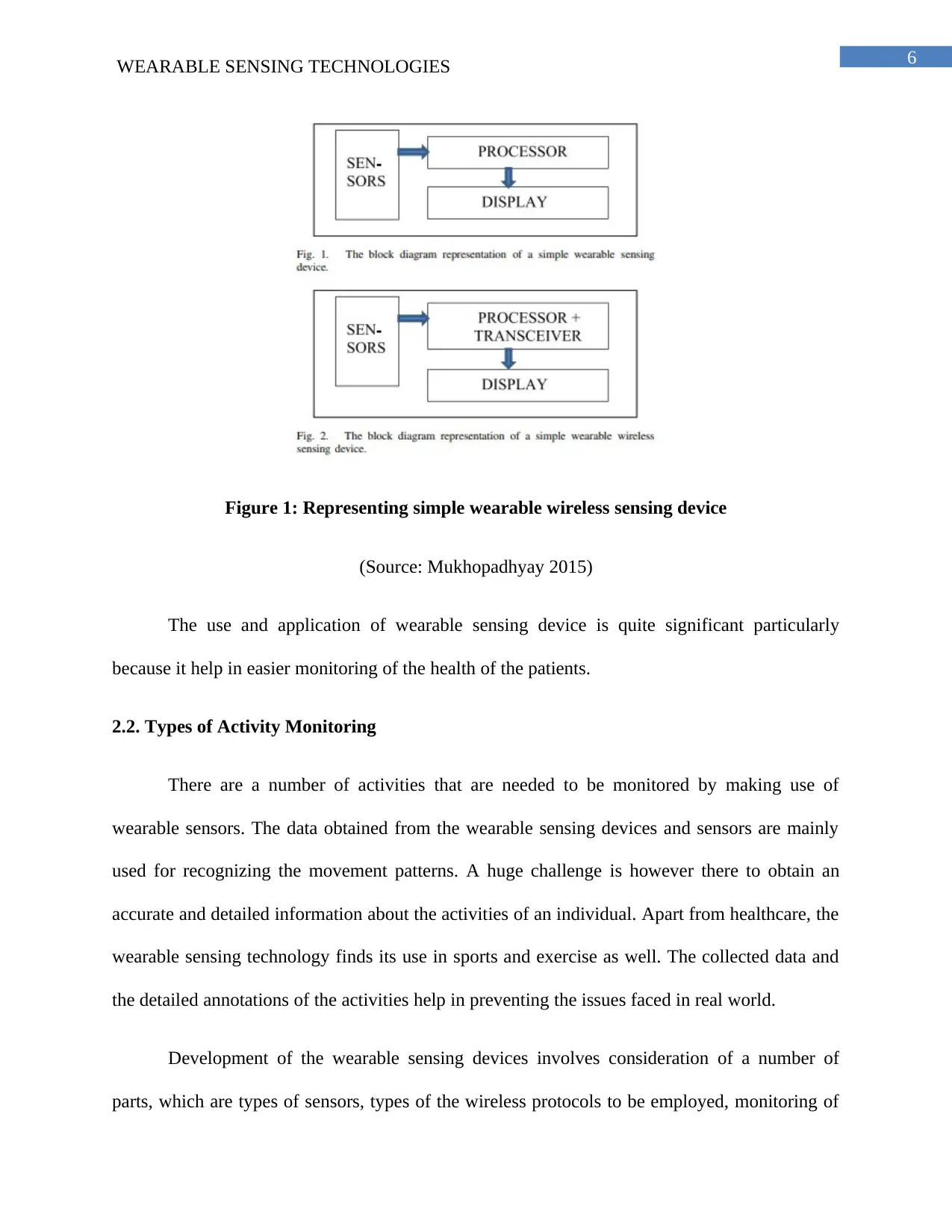
6WEARABLE SENSING TECHNOLOGIES
Figure 1: Representing simple wearable wireless sensing device
(Source: Mukhopadhyay 2015)
The use and application of wearable sensing device is quite significant particularly
because it help in easier monitoring of the health of the patients.
2.2. Types of Activity Monitoring
There are a number of activities that are needed to be monitored by making use of
wearable sensors. The data obtained from the wearable sensing devices and sensors are mainly
used for recognizing the movement patterns. A huge challenge is however there to obtain an
accurate and detailed information about the activities of an individual. Apart from healthcare, the
wearable sensing technology finds its use in sports and exercise as well. The collected data and
the detailed annotations of the activities help in preventing the issues faced in real world.
Development of the wearable sensing devices involves consideration of a number of
parts, which are types of sensors, types of the wireless protocols to be employed, monitoring of
Figure 1: Representing simple wearable wireless sensing device
(Source: Mukhopadhyay 2015)
The use and application of wearable sensing device is quite significant particularly
because it help in easier monitoring of the health of the patients.
2.2. Types of Activity Monitoring
There are a number of activities that are needed to be monitored by making use of
wearable sensors. The data obtained from the wearable sensing devices and sensors are mainly
used for recognizing the movement patterns. A huge challenge is however there to obtain an
accurate and detailed information about the activities of an individual. Apart from healthcare, the
wearable sensing technology finds its use in sports and exercise as well. The collected data and
the detailed annotations of the activities help in preventing the issues faced in real world.
Development of the wearable sensing devices involves consideration of a number of
parts, which are types of sensors, types of the wireless protocols to be employed, monitoring of
Paraphrase This Document
Need a fresh take? Get an instant paraphrase of this document with our AI Paraphraser
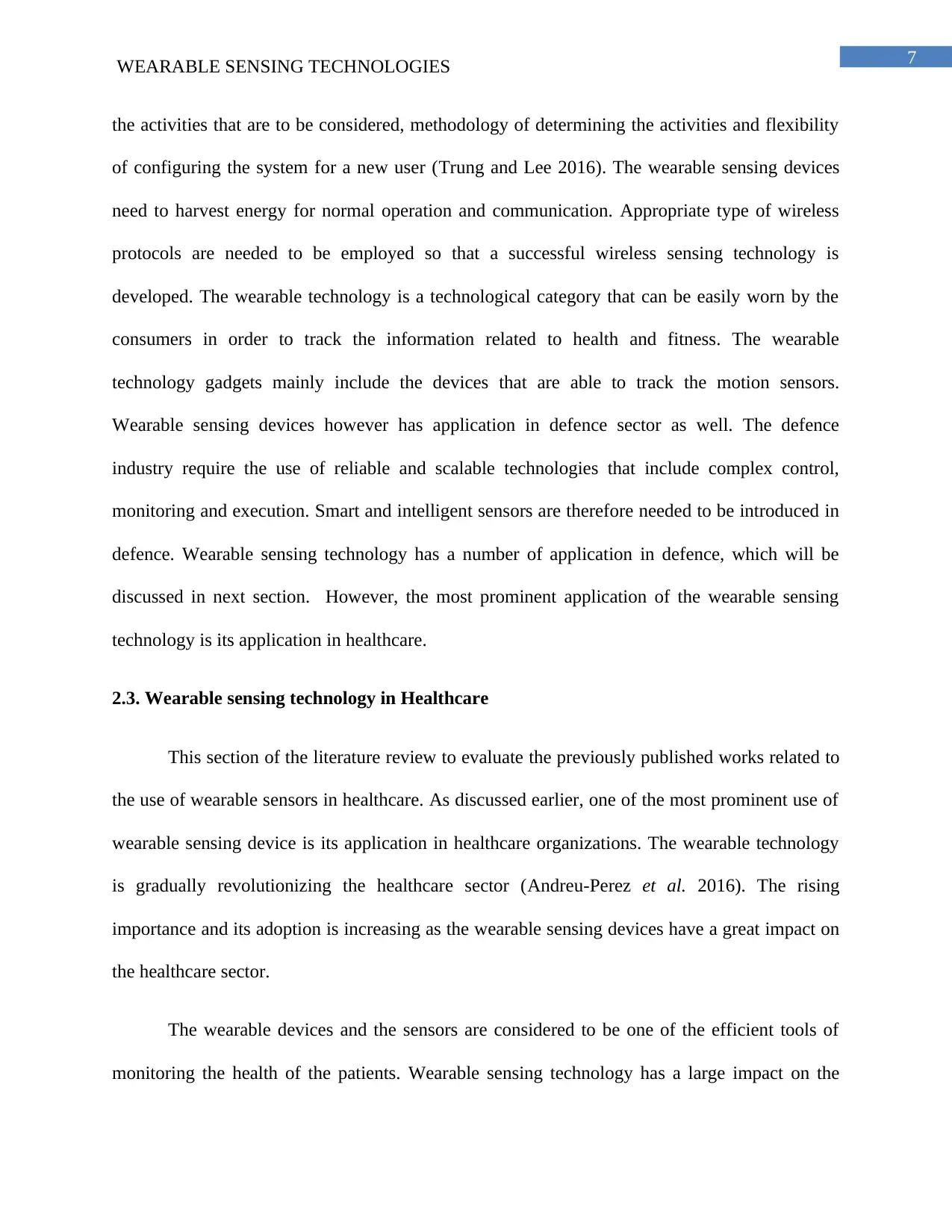
7WEARABLE SENSING TECHNOLOGIES
the activities that are to be considered, methodology of determining the activities and flexibility
of configuring the system for a new user (Trung and Lee 2016). The wearable sensing devices
need to harvest energy for normal operation and communication. Appropriate type of wireless
protocols are needed to be employed so that a successful wireless sensing technology is
developed. The wearable technology is a technological category that can be easily worn by the
consumers in order to track the information related to health and fitness. The wearable
technology gadgets mainly include the devices that are able to track the motion sensors.
Wearable sensing devices however has application in defence sector as well. The defence
industry require the use of reliable and scalable technologies that include complex control,
monitoring and execution. Smart and intelligent sensors are therefore needed to be introduced in
defence. Wearable sensing technology has a number of application in defence, which will be
discussed in next section. However, the most prominent application of the wearable sensing
technology is its application in healthcare.
2.3. Wearable sensing technology in Healthcare
This section of the literature review to evaluate the previously published works related to
the use of wearable sensors in healthcare. As discussed earlier, one of the most prominent use of
wearable sensing device is its application in healthcare organizations. The wearable technology
is gradually revolutionizing the healthcare sector (Andreu-Perez et al. 2016). The rising
importance and its adoption is increasing as the wearable sensing devices have a great impact on
the healthcare sector.
The wearable devices and the sensors are considered to be one of the efficient tools of
monitoring the health of the patients. Wearable sensing technology has a large impact on the
the activities that are to be considered, methodology of determining the activities and flexibility
of configuring the system for a new user (Trung and Lee 2016). The wearable sensing devices
need to harvest energy for normal operation and communication. Appropriate type of wireless
protocols are needed to be employed so that a successful wireless sensing technology is
developed. The wearable technology is a technological category that can be easily worn by the
consumers in order to track the information related to health and fitness. The wearable
technology gadgets mainly include the devices that are able to track the motion sensors.
Wearable sensing devices however has application in defence sector as well. The defence
industry require the use of reliable and scalable technologies that include complex control,
monitoring and execution. Smart and intelligent sensors are therefore needed to be introduced in
defence. Wearable sensing technology has a number of application in defence, which will be
discussed in next section. However, the most prominent application of the wearable sensing
technology is its application in healthcare.
2.3. Wearable sensing technology in Healthcare
This section of the literature review to evaluate the previously published works related to
the use of wearable sensors in healthcare. As discussed earlier, one of the most prominent use of
wearable sensing device is its application in healthcare organizations. The wearable technology
is gradually revolutionizing the healthcare sector (Andreu-Perez et al. 2016). The rising
importance and its adoption is increasing as the wearable sensing devices have a great impact on
the healthcare sector.
The wearable devices and the sensors are considered to be one of the efficient tools of
monitoring the health of the patients. Wearable sensing technology has a large impact on the
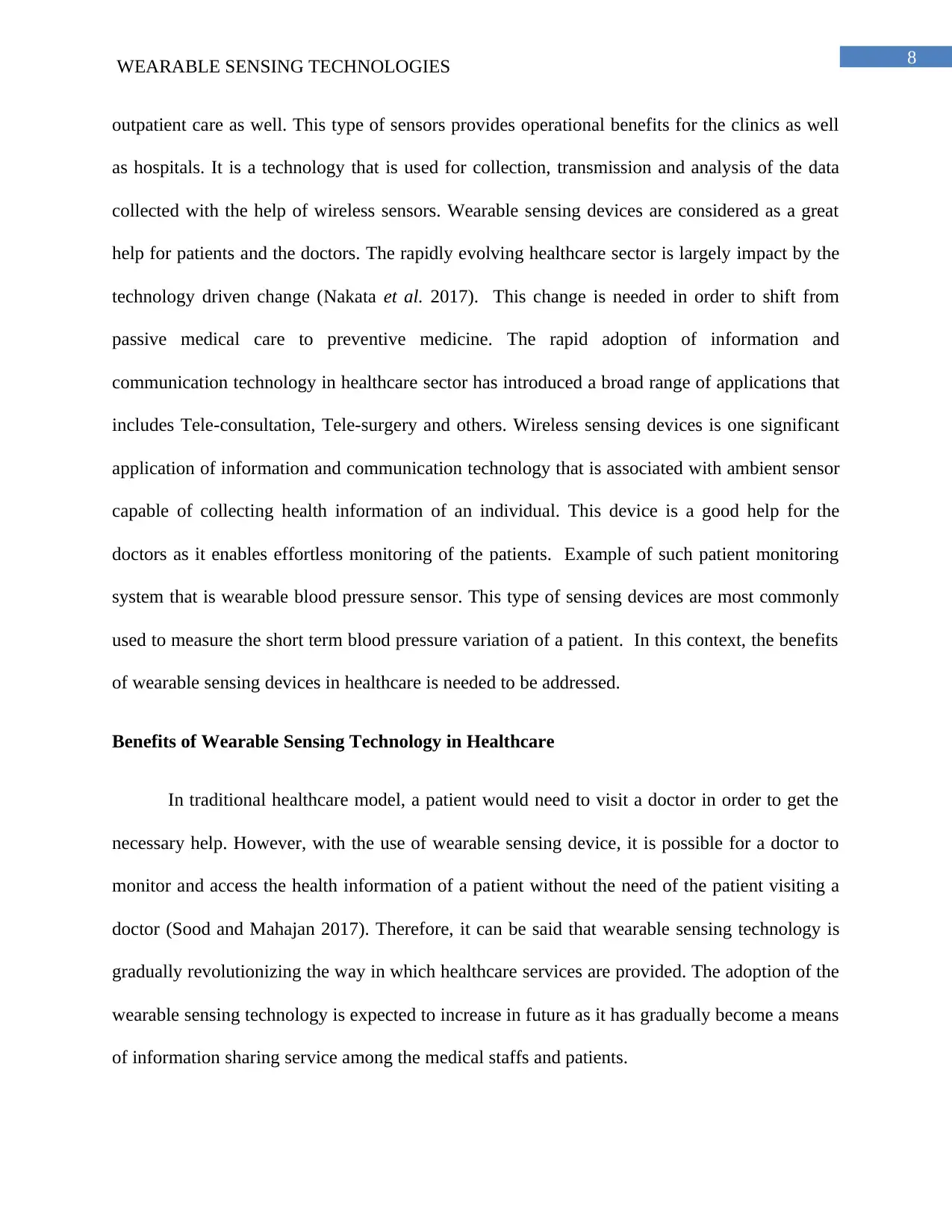
8WEARABLE SENSING TECHNOLOGIES
outpatient care as well. This type of sensors provides operational benefits for the clinics as well
as hospitals. It is a technology that is used for collection, transmission and analysis of the data
collected with the help of wireless sensors. Wearable sensing devices are considered as a great
help for patients and the doctors. The rapidly evolving healthcare sector is largely impact by the
technology driven change (Nakata et al. 2017). This change is needed in order to shift from
passive medical care to preventive medicine. The rapid adoption of information and
communication technology in healthcare sector has introduced a broad range of applications that
includes Tele-consultation, Tele-surgery and others. Wireless sensing devices is one significant
application of information and communication technology that is associated with ambient sensor
capable of collecting health information of an individual. This device is a good help for the
doctors as it enables effortless monitoring of the patients. Example of such patient monitoring
system that is wearable blood pressure sensor. This type of sensing devices are most commonly
used to measure the short term blood pressure variation of a patient. In this context, the benefits
of wearable sensing devices in healthcare is needed to be addressed.
Benefits of Wearable Sensing Technology in Healthcare
In traditional healthcare model, a patient would need to visit a doctor in order to get the
necessary help. However, with the use of wearable sensing device, it is possible for a doctor to
monitor and access the health information of a patient without the need of the patient visiting a
doctor (Sood and Mahajan 2017). Therefore, it can be said that wearable sensing technology is
gradually revolutionizing the way in which healthcare services are provided. The adoption of the
wearable sensing technology is expected to increase in future as it has gradually become a means
of information sharing service among the medical staffs and patients.
outpatient care as well. This type of sensors provides operational benefits for the clinics as well
as hospitals. It is a technology that is used for collection, transmission and analysis of the data
collected with the help of wireless sensors. Wearable sensing devices are considered as a great
help for patients and the doctors. The rapidly evolving healthcare sector is largely impact by the
technology driven change (Nakata et al. 2017). This change is needed in order to shift from
passive medical care to preventive medicine. The rapid adoption of information and
communication technology in healthcare sector has introduced a broad range of applications that
includes Tele-consultation, Tele-surgery and others. Wireless sensing devices is one significant
application of information and communication technology that is associated with ambient sensor
capable of collecting health information of an individual. This device is a good help for the
doctors as it enables effortless monitoring of the patients. Example of such patient monitoring
system that is wearable blood pressure sensor. This type of sensing devices are most commonly
used to measure the short term blood pressure variation of a patient. In this context, the benefits
of wearable sensing devices in healthcare is needed to be addressed.
Benefits of Wearable Sensing Technology in Healthcare
In traditional healthcare model, a patient would need to visit a doctor in order to get the
necessary help. However, with the use of wearable sensing device, it is possible for a doctor to
monitor and access the health information of a patient without the need of the patient visiting a
doctor (Sood and Mahajan 2017). Therefore, it can be said that wearable sensing technology is
gradually revolutionizing the way in which healthcare services are provided. The adoption of the
wearable sensing technology is expected to increase in future as it has gradually become a means
of information sharing service among the medical staffs and patients.
⊘ This is a preview!⊘
Do you want full access?
Subscribe today to unlock all pages.

Trusted by 1+ million students worldwide
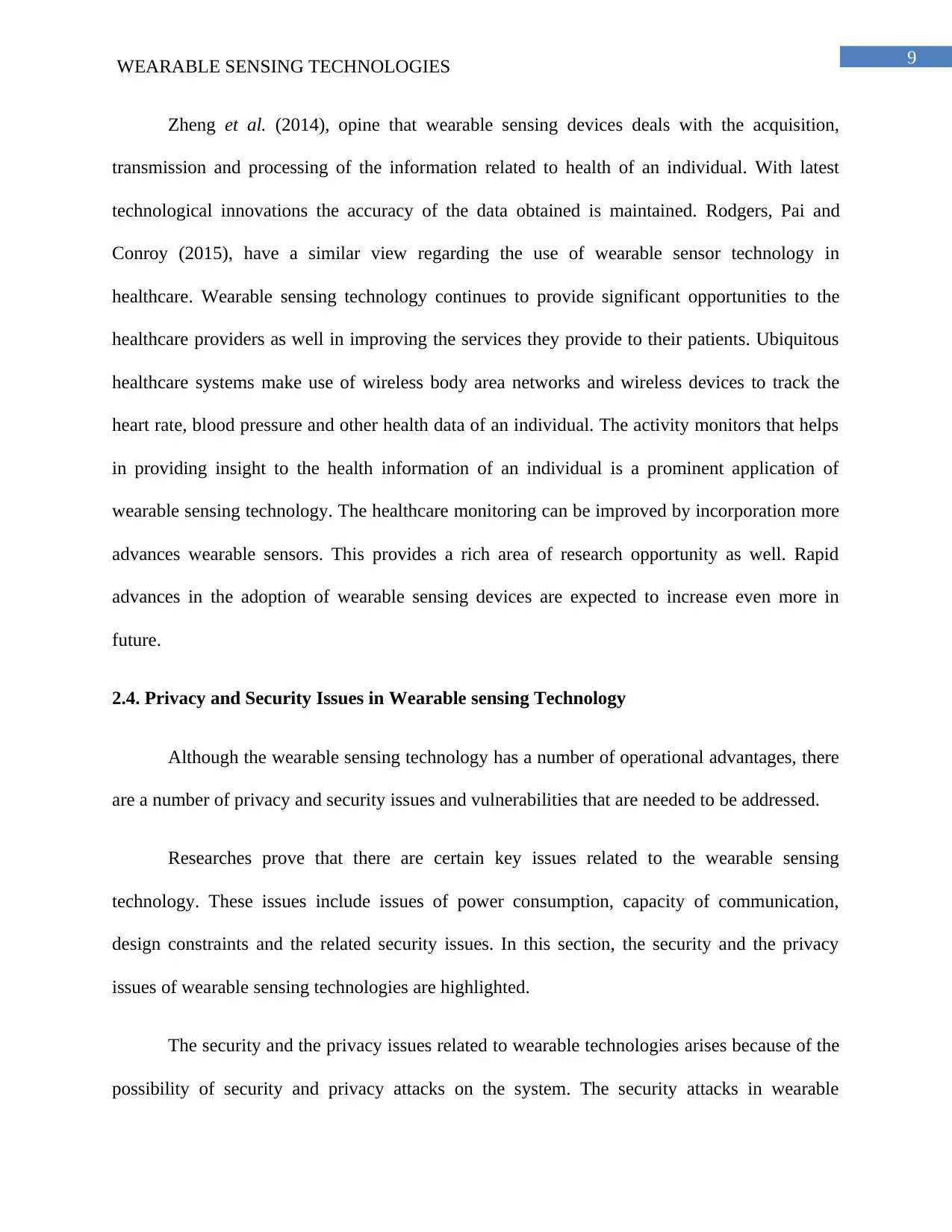
9WEARABLE SENSING TECHNOLOGIES
Zheng et al. (2014), opine that wearable sensing devices deals with the acquisition,
transmission and processing of the information related to health of an individual. With latest
technological innovations the accuracy of the data obtained is maintained. Rodgers, Pai and
Conroy (2015), have a similar view regarding the use of wearable sensor technology in
healthcare. Wearable sensing technology continues to provide significant opportunities to the
healthcare providers as well in improving the services they provide to their patients. Ubiquitous
healthcare systems make use of wireless body area networks and wireless devices to track the
heart rate, blood pressure and other health data of an individual. The activity monitors that helps
in providing insight to the health information of an individual is a prominent application of
wearable sensing technology. The healthcare monitoring can be improved by incorporation more
advances wearable sensors. This provides a rich area of research opportunity as well. Rapid
advances in the adoption of wearable sensing devices are expected to increase even more in
future.
2.4. Privacy and Security Issues in Wearable sensing Technology
Although the wearable sensing technology has a number of operational advantages, there
are a number of privacy and security issues and vulnerabilities that are needed to be addressed.
Researches prove that there are certain key issues related to the wearable sensing
technology. These issues include issues of power consumption, capacity of communication,
design constraints and the related security issues. In this section, the security and the privacy
issues of wearable sensing technologies are highlighted.
The security and the privacy issues related to wearable technologies arises because of the
possibility of security and privacy attacks on the system. The security attacks in wearable
Zheng et al. (2014), opine that wearable sensing devices deals with the acquisition,
transmission and processing of the information related to health of an individual. With latest
technological innovations the accuracy of the data obtained is maintained. Rodgers, Pai and
Conroy (2015), have a similar view regarding the use of wearable sensor technology in
healthcare. Wearable sensing technology continues to provide significant opportunities to the
healthcare providers as well in improving the services they provide to their patients. Ubiquitous
healthcare systems make use of wireless body area networks and wireless devices to track the
heart rate, blood pressure and other health data of an individual. The activity monitors that helps
in providing insight to the health information of an individual is a prominent application of
wearable sensing technology. The healthcare monitoring can be improved by incorporation more
advances wearable sensors. This provides a rich area of research opportunity as well. Rapid
advances in the adoption of wearable sensing devices are expected to increase even more in
future.
2.4. Privacy and Security Issues in Wearable sensing Technology
Although the wearable sensing technology has a number of operational advantages, there
are a number of privacy and security issues and vulnerabilities that are needed to be addressed.
Researches prove that there are certain key issues related to the wearable sensing
technology. These issues include issues of power consumption, capacity of communication,
design constraints and the related security issues. In this section, the security and the privacy
issues of wearable sensing technologies are highlighted.
The security and the privacy issues related to wearable technologies arises because of the
possibility of security and privacy attacks on the system. The security attacks in wearable
Paraphrase This Document
Need a fresh take? Get an instant paraphrase of this document with our AI Paraphraser
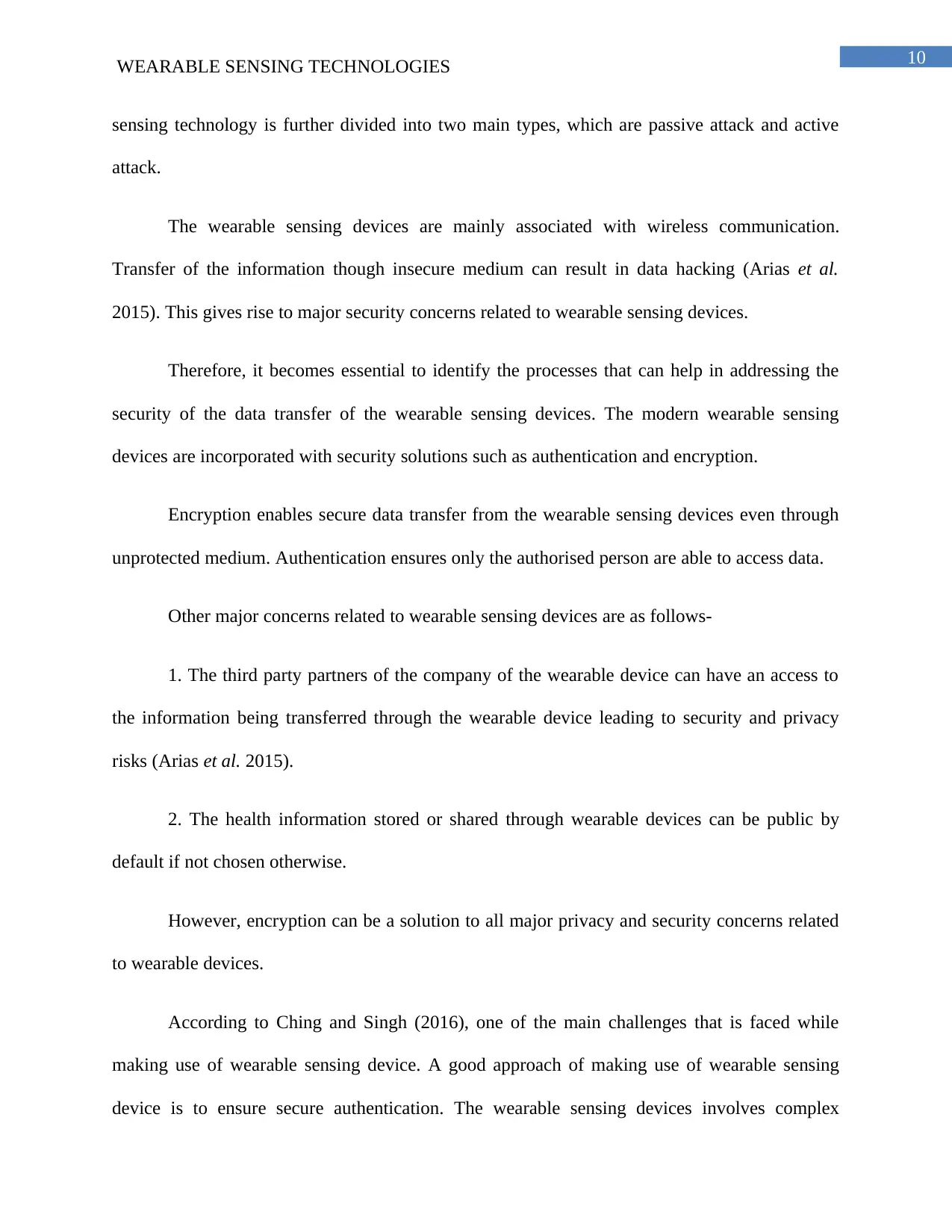
10WEARABLE SENSING TECHNOLOGIES
sensing technology is further divided into two main types, which are passive attack and active
attack.
The wearable sensing devices are mainly associated with wireless communication.
Transfer of the information though insecure medium can result in data hacking (Arias et al.
2015). This gives rise to major security concerns related to wearable sensing devices.
Therefore, it becomes essential to identify the processes that can help in addressing the
security of the data transfer of the wearable sensing devices. The modern wearable sensing
devices are incorporated with security solutions such as authentication and encryption.
Encryption enables secure data transfer from the wearable sensing devices even through
unprotected medium. Authentication ensures only the authorised person are able to access data.
Other major concerns related to wearable sensing devices are as follows-
1. The third party partners of the company of the wearable device can have an access to
the information being transferred through the wearable device leading to security and privacy
risks (Arias et al. 2015).
2. The health information stored or shared through wearable devices can be public by
default if not chosen otherwise.
However, encryption can be a solution to all major privacy and security concerns related
to wearable devices.
According to Ching and Singh (2016), one of the main challenges that is faced while
making use of wearable sensing device. A good approach of making use of wearable sensing
device is to ensure secure authentication. The wearable sensing devices involves complex
sensing technology is further divided into two main types, which are passive attack and active
attack.
The wearable sensing devices are mainly associated with wireless communication.
Transfer of the information though insecure medium can result in data hacking (Arias et al.
2015). This gives rise to major security concerns related to wearable sensing devices.
Therefore, it becomes essential to identify the processes that can help in addressing the
security of the data transfer of the wearable sensing devices. The modern wearable sensing
devices are incorporated with security solutions such as authentication and encryption.
Encryption enables secure data transfer from the wearable sensing devices even through
unprotected medium. Authentication ensures only the authorised person are able to access data.
Other major concerns related to wearable sensing devices are as follows-
1. The third party partners of the company of the wearable device can have an access to
the information being transferred through the wearable device leading to security and privacy
risks (Arias et al. 2015).
2. The health information stored or shared through wearable devices can be public by
default if not chosen otherwise.
However, encryption can be a solution to all major privacy and security concerns related
to wearable devices.
According to Ching and Singh (2016), one of the main challenges that is faced while
making use of wearable sensing device. A good approach of making use of wearable sensing
device is to ensure secure authentication. The wearable sensing devices involves complex
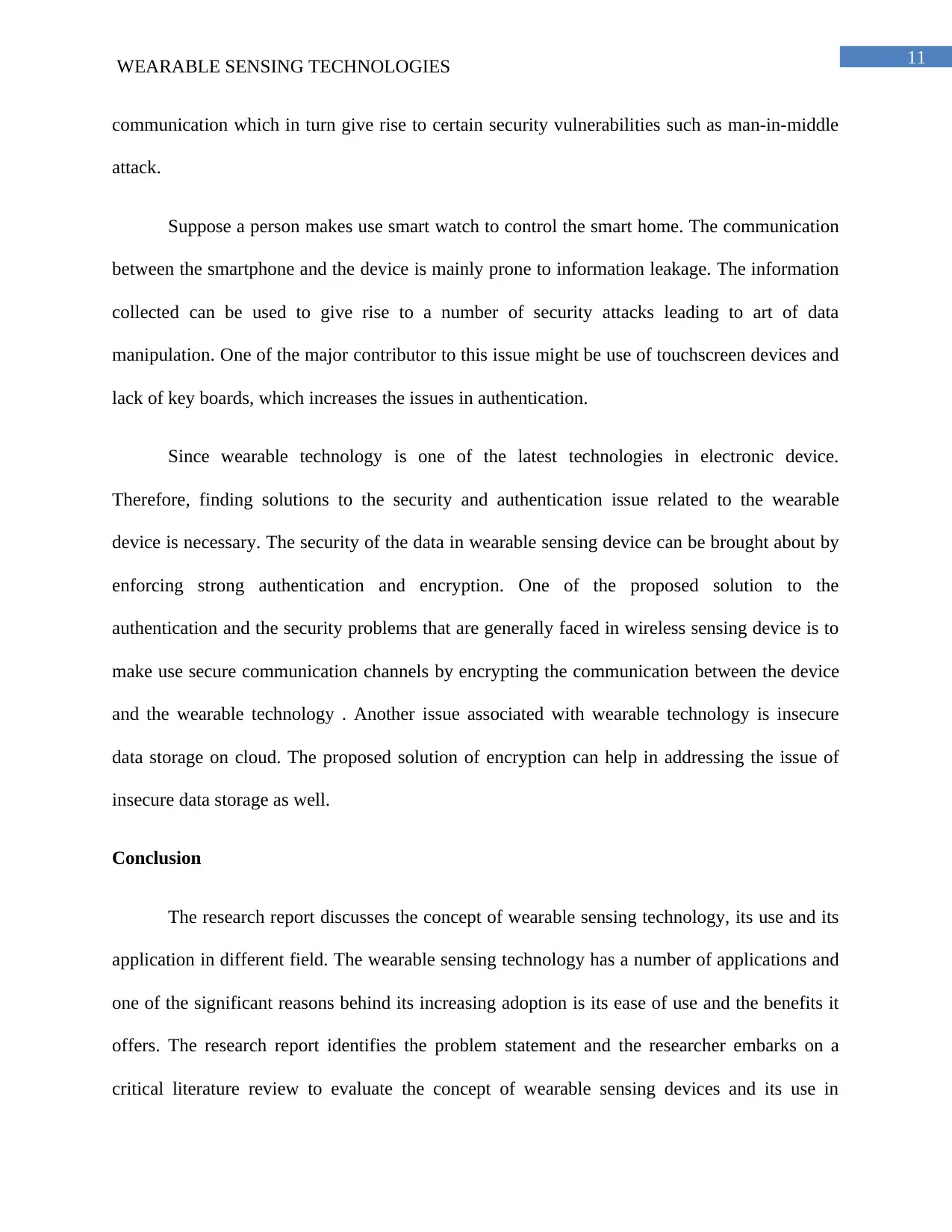
11WEARABLE SENSING TECHNOLOGIES
communication which in turn give rise to certain security vulnerabilities such as man-in-middle
attack.
Suppose a person makes use smart watch to control the smart home. The communication
between the smartphone and the device is mainly prone to information leakage. The information
collected can be used to give rise to a number of security attacks leading to art of data
manipulation. One of the major contributor to this issue might be use of touchscreen devices and
lack of key boards, which increases the issues in authentication.
Since wearable technology is one of the latest technologies in electronic device.
Therefore, finding solutions to the security and authentication issue related to the wearable
device is necessary. The security of the data in wearable sensing device can be brought about by
enforcing strong authentication and encryption. One of the proposed solution to the
authentication and the security problems that are generally faced in wireless sensing device is to
make use secure communication channels by encrypting the communication between the device
and the wearable technology . Another issue associated with wearable technology is insecure
data storage on cloud. The proposed solution of encryption can help in addressing the issue of
insecure data storage as well.
Conclusion
The research report discusses the concept of wearable sensing technology, its use and its
application in different field. The wearable sensing technology has a number of applications and
one of the significant reasons behind its increasing adoption is its ease of use and the benefits it
offers. The research report identifies the problem statement and the researcher embarks on a
critical literature review to evaluate the concept of wearable sensing devices and its use in
communication which in turn give rise to certain security vulnerabilities such as man-in-middle
attack.
Suppose a person makes use smart watch to control the smart home. The communication
between the smartphone and the device is mainly prone to information leakage. The information
collected can be used to give rise to a number of security attacks leading to art of data
manipulation. One of the major contributor to this issue might be use of touchscreen devices and
lack of key boards, which increases the issues in authentication.
Since wearable technology is one of the latest technologies in electronic device.
Therefore, finding solutions to the security and authentication issue related to the wearable
device is necessary. The security of the data in wearable sensing device can be brought about by
enforcing strong authentication and encryption. One of the proposed solution to the
authentication and the security problems that are generally faced in wireless sensing device is to
make use secure communication channels by encrypting the communication between the device
and the wearable technology . Another issue associated with wearable technology is insecure
data storage on cloud. The proposed solution of encryption can help in addressing the issue of
insecure data storage as well.
Conclusion
The research report discusses the concept of wearable sensing technology, its use and its
application in different field. The wearable sensing technology has a number of applications and
one of the significant reasons behind its increasing adoption is its ease of use and the benefits it
offers. The research report identifies the problem statement and the researcher embarks on a
critical literature review to evaluate the concept of wearable sensing devices and its use in
⊘ This is a preview!⊘
Do you want full access?
Subscribe today to unlock all pages.

Trusted by 1+ million students worldwide
1 out of 15
Related Documents
Your All-in-One AI-Powered Toolkit for Academic Success.
+13062052269
info@desklib.com
Available 24*7 on WhatsApp / Email
![[object Object]](/_next/static/media/star-bottom.7253800d.svg)
Unlock your academic potential
Copyright © 2020–2025 A2Z Services. All Rights Reserved. Developed and managed by ZUCOL.





